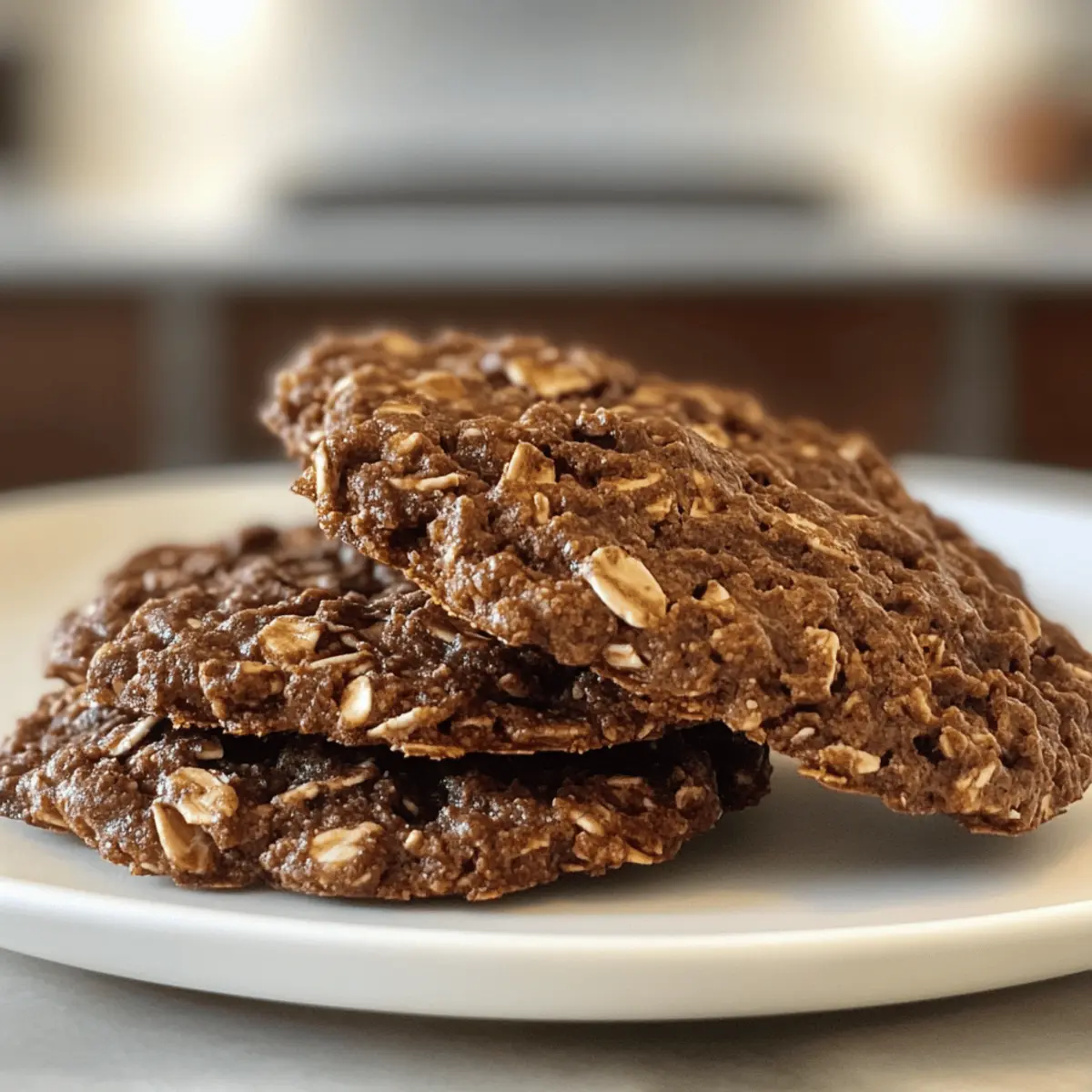Caught in a whirlwind after a long day, I found myself questioning my dinner plans. That’s when inspiration struck—what if I could transform a classic comfort dish into something both unique and heartwarming? Enter my Korean Style Pot Roast! This rich and savory dish brings a tender, melt-in-your-mouth experience that feels like a warm hug. Not only is it a fantastic way to cozy up during the colder months, but it also offers a delightful twist on traditional roasts, making it a perfect centerpiece for gatherings or a comforting weeknight meal. And the best part? You can prep it in just a few minutes, leaving you free to enjoy more quality time with your loved ones. Curious about how this savory sensation could become your next go-to recipe? Let’s dive in!

Why Try This Korean Style Pot Roast?
Flavor Explosion: The robust blend of Korean spices creates a mouthwatering depth that elevates your classic pot roast to a whole new level.
Effortless Prep: Imagine a dish that takes mere minutes to prepare yet delivers big on taste. With simple steps, dinner can basically make itself!
Versatile Delight: Serve it over rice for a comforting meal or in tacos for a fun twist—this pot roast adapts to any occasion.
Crowd-Pleaser: Whether you’re hosting a dinner party or simply feeding the family, this dish will have everyone coming back for seconds.
Make-Ahead Magic: Perfect for busy weeks, you can prepare the roast in advance and let it simmer while you unwind. Don’t forget to check out my Crock Pot Crack for another effortless meal idea!
Korean Style Pot Roast Ingredients
For the Roast
- Chuck Roast – A well-marbled cut that becomes incredibly tender during slow cooking.
- Soy Sauce – Adds a savory depth; use low-sodium for a healthier option.
- Garlic – Freshly minced garlic infuses the roast with bold flavor; feel free to adjust to taste.
- Ginger – Fresh ginger provides a fragrant warmth; powdered ginger works in a pinch but adjust the quantity.
For the Vegetables
- Carrots – These sweet, tender veggies become even more flavorful when roasted.
- Onion – Adds sweetness and keeps the meat juicy; yellow or sweet onions work beautifully.
- Mushrooms – Their umami richness complements the pot roast; opt for shiitake or cremini for an earthy touch.
- Green Onions – Use these as a fresh garnish; they add color and a mild onion bite.
For the Marinade
- Brown Sugar – Balances out the savory flavors; feel free to substitute with honey or coconut sugar for a twist.
- Sesame Oil – A few drops enhance the dish with a nutty aroma; optional but highly recommended.
- Red Pepper Flakes – Adjust these to your heat preference for a slight kick in the flavor profile.
Transforming your cooking routine with this Korean Style Pot Roast will leave everyone craving more!
Step‑by‑Step Instructions for Korean Style Pot Roast
Step 1: Prepare the Marinade
In a mixing bowl, combine soy sauce, minced garlic, freshly grated ginger, brown sugar, sesame oil, and red pepper flakes to create a rich marinade for your Korean Style Pot Roast. Whisk these ingredients together until well blended, ensuring the sugar has dissolved. Allow the marinade to rest for a few minutes to let the flavors meld, while you prepare your vegetables.
Step 2: Sear the Roast
Heat a large skillet over medium-high heat and add a splash of oil to prevent sticking. Once hot, sear the chuck roast for about 4-5 minutes on each side until a beautiful brown crust forms. This step locks in juices and creates depth in flavor for your pot roast. After searing, transfer the roast to a slow cooker or a heavy-duty roasting pan.
Step 3: Add the Vegetables
In the same skillet, toss in chopped carrots, sliced onions, and mushrooms, sautéing them for about 3-4 minutes until they start to soften and caramelize. This enhances their natural sweetness and develops a lovely base for your dish. Once tender, layer the vegetables around the seared beef in the slow cooker or pan, ensuring even distribution for optimal flavor infusion.
Step 4: Pour the Marinade
Now, pour the prepared marinade evenly over the seared roast and vegetables, ensuring everything is well coated. If using a slow cooker, cover it with a lid, set it on low, and let it cook for 8 hours for tender, melt-in-your-mouth meat. If roasting, cover the pan tightly with foil and bake in a preheated oven at 325°F (163°C) for about 3-4 hours.
Step 5: Check for Doneness
After the cooking time is up, carefully check the pot roast for doneness—fork-tender with a beautiful sauce. If the meat easily pulls apart, your Korean Style Pot Roast is ready. Use a meat thermometer to ensure the internal temperature has reached 190°F (88°C) for optimal tenderness, especially for a chuck roast.
Step 6: Let it Rest
Remove the pot roast from the heat and let it rest for about 15-20 minutes, covered loosely with foil. Resting allows the juices to redistribute throughout the meat, ensuring every bite is succulent and flavorful. While it rests, prepare your preferred side dishes, such as rice or steamed veggies, for a complete meal.
Step 7: Serve and Garnish
Slice or shred the pot roast according to your preference and serve it over fluffy rice or in tacos for a fun twist. Drizzle some of the savory cooking juices atop the meat for added flavor. Finally, garnish with chopped green onions to introduce freshness and a pop of color, completing your magnificent Korean Style Pot Roast!

Make Ahead Options
These Korean Style Pot Roast preparations are perfect for busy weeknights or meal planning! You can make the marinade and let it sit in the refrigerator for up to 24 hours to enhance the flavors before incorporating it into the recipe. Additionally, feel free to chop your vegetables (carrots, onions, and mushrooms) a day in advance and store them in an airtight container in the fridge. Just before serving, simply sear the roast, add the vegetables, and pour in your marinade. This way, you’ll save significant time during the week while ensuring that your pot roast remains just as delicious with all its flavors intact!
Expert Tips for Korean Style Pot Roast
Choose the Right Cut: Select a well-marbled chuck roast to ensure maximum tenderness during slow cooking; this is key for a perfect Korean Style Pot Roast.
Don’t Skip Searing: Searing the roast before cooking adds a delicious crust and enhances flavor; take your time with this step for the best results.
Let It Rest: Rest the pot roast after cooking for 15-20 minutes. This step redistributes the juices, ensuring each slice or shred is flavorful and moist.
Adjust Seasoning: Feel free to tweak the marinade’s sweetness or spice level to suit your taste. Don’t hesitate to play with the red pepper flakes for the perfect kick!
Perfect Pairing: Serve your pot roast with fluffy rice or in soft tortillas for a creative twist. This dish is versatile and is sure to please everyone at the table!
Variations & Substitutions for Korean Style Pot Roast
Feel free to get creative and transform this dish to suit your taste buds and dietary preferences!
-
Gluten-Free: Use tamari instead of soy sauce to keep it gluten-free while maintaining that savory depth of flavor.
This small swap can make a world of difference for those avoiding gluten. Plus, it pairs beautifully with the other ingredients. -
Spicy Kick: Add more red pepper flakes or a dash of gochujang for an added layer of heat and complexity.
The richness of the roast perfectly balances with the heat, making each bite an adventure for your palate. -
Vegetable Variety: Replace the carrots and mushrooms with your favorite veggies like bell peppers or zucchini.
This keeps things fresh and exciting, adapting not only the flavor but also adding vibrant colors to your plate. -
Sweet Alternative: Experiment with honey or coconut sugar as a substitute for brown sugar for a different sweetness profile.
Each option brings its unique sweetness, offering a lovely variation to suit your preferences or dietary needs. -
Herbal Infusion: Add a bouquet garni of fresh herbs like thyme or rosemary for an aromatic twist.
The infusion of herbs provides a lovely fragrant layer that elevates the dish to a different realm of delightful flavors. -
Beef Alternative: Use pork shoulder for a different but equally delicious take on this recipe.
This will change the flavor profile slightly while still providing that melt-in-your-mouth tenderness you’re craving. -
Keto-Friendly: Swap brown sugar for a keto-friendly alternative like erythritol for a low-carb indulgence.
You can enjoy the same delicious dish while adhering to your keto lifestyle, ensuring no compromise on flavor! -
Add Creaminess: Stir in a dollop of sour cream or Greek yogurt just before serving for a creamy finish.
This twist adds a luscious richness that complements the savory notes of the roast, making it even more enjoyable!
If you’re looking for more quick and delicious meals, don’t miss my One Pot Garlic or give the Crock Pot Crack recipe a try. Each offers unique flavors and convenience to spice up your dinner routine!
Storage Tips for Korean Style Pot Roast
Room Temperature: Allow the pot roast to cool before storing; it can sit out for no more than 2 hours to prevent bacterial growth.
Fridge: Store leftover Korean Style Pot Roast in an airtight container for up to 3 days. Ensure it’s cooled completely before sealing to maintain freshness.
Freezer: For longer storage, freeze the pot roast in a freezer-safe bag or container for up to 3 months. Thaw in the fridge overnight before reheating.
Reheating: When ready to enjoy leftovers, reheat in a skillet over medium heat or in the microwave until warmed through. Drizzle with a bit of broth or water to retain moisture.
What to Serve with 4-Ingredient Crispy Chocolate Oat Cookies
Indulging in these delightful cookies offers the perfect opportunity to craft an entire spread that delights the senses and warms the heart.
-
Fresh Fruit Salad: A mix of juicy berries and crisp apples provides a refreshing contrast to the cookies’ rich chocolate flavors.
-
Creamy Yogurt Parfait: Layer yogurt with granola and a drizzle of honey; the creaminess is a luscious addition to the crunchy cookies.
-
Dairy-Free Milk Alternatives: Pair your cookies with almond or oat milk for a plant-based option that complements the chocolate beautifully.
-
Coffee or Espresso: The robust flavors of coffee harmonize well with the sweetness of the cookies, making for a cozy afternoon treat.
-
Chocolate Drizzle: Drizzling melted dark chocolate over the cookies elevates their indulgence, perfect for the ultimate chocolate lover.
-
Nut Butter Spread: Serve with a side of almond or peanut butter for dipping, adding a creamy richness that balances the cookie’s crunch.
-
Ice Cream Sandwiches: Sandwich a scoop of vanilla ice cream between two cookies for a blissful dessert experience, perfect for sharing!
-
Coconut Milk Whipped Cream: A dollop of this light and fluffy cream adds a tropical twist, soothing the sweetness with its airy texture.
Elevate your cookie experience by pairing these delicious options, creating a cozy atmosphere perfect for sharing with friends and family.

Korean Style Pot Roast Recipe FAQs
What cut of beef should I use for Korean Style Pot Roast?
Absolutely! A well-marbled chuck roast is the best choice as it becomes incredibly tender during slow cooking. The marbling helps keep the meat juicy and flavorful. If you’re looking for alternatives, you can also try a brisket or round roast, but be aware that cooking times may vary slightly.
How long can I store leftovers in the refrigerator?
Very! Leftover Korean Style Pot Roast can be stored in an airtight container in the fridge for up to 3 days. Make sure to let it cool completely before sealing to maintain the best texture and flavor.
Can I freeze Korean Style Pot Roast?
Yes, you can! For longer storage, freeze your pot roast in a freezer-safe bag or container for up to 3 months. It’s best to slice or shred the meat before freezing to make reheating easier. When you’re ready to enjoy it, thaw it in the fridge overnight and reheat gently on the stovetop or in the microwave.
What should I do if my pot roast isn’t tender after cooking?
Great question! If your pot roast isn’t tender after the recommended cooking time, it might need a little extra love. Try cooking it for another 30 minutes to an hour. Make sure to check the internal temperature—aim for at least 190°F (88°C) for that melt-in-your-mouth texture. If you cooked it in the oven, ensure the cover is tight to retain moisture.
Are there any dietary considerations for Korean Style Pot Roast?
Absolutely! If you’re serving guests with dietary restrictions, consider using tamari instead of soy sauce for a gluten-free option. Additionally, you can adjust the sweetness level by substituting brown sugar with coconut sugar or honey based on personal preference. Also, ensure that all vegetables used are fresh and suitable for anyone with allergies.
How can I enhance the flavors while cooking?
Fantastic idea! You can enhance the flavors by incorporating additional spices or aromatics such as star anise, a splash of rice wine, or even a dash of sesame oil in the marinade. Feel free to add vegetables like potatoes or bell peppers for a heartier meal. Mixing in these variations can truly elevate your Korean Style Pot Roast experience!

Mouthwatering Korean Style Pot Roast: A Flavorful Feast
Ingredients
Equipment
Method
- Prepare the Marinade: In a mixing bowl, combine soy sauce, minced garlic, freshly grated ginger, brown sugar, sesame oil, and red pepper flakes. Whisk until well blended and allow to rest.
- Sear the Roast: Heat a skillet over medium-high heat, sear the chuck roast for 4-5 minutes on each side until browned, then transfer to a slow cooker.
- Add the Vegetables: In the same skillet, sauté carrots, onions, and mushrooms for 3-4 minutes, then layer around the beef in the slow cooker.
- Pour the Marinade: Pour the marinade over the roast and vegetables, cover, and cook on low for 8 hours.
- Check for Doneness: Ensure the meat is fork-tender and the internal temperature reaches 190°F (88°C).
- Let it Rest: Allow the roast to rest for 15-20 minutes covered loosely with foil.
- Serve and Garnish: Slice or shred, serve over rice or in tacos, and garnish with chopped green onions.

Leave a Reply